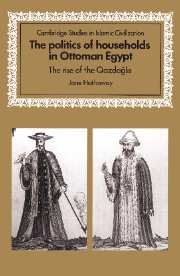Book contents
- Frontmatter
- Contents
- Note on transliteration
- List of illustrations
- List of tables
- Preface
- List of abbreviations
- Genealogical tables
- Introduction
- I The household and its place in Ottoman Egypt's history
- Chapter 1 Egypt's place in the Ottoman Empire
- Chapter 2 The household
- Chapter 3 Transformations in seventeenth- and eighteenth-century Egyptian military society
- Chapter 4 The emergence and partnership of the Qazdağli and Jalfi households
- Chapter 5 The ascendancy of Ibrahim Kâhya al-Qazdağli and the emergence of the Qazdağli beylicate
- II Qazdağli household-building strategies
- Glossary
- Bibliography
- Index
Chapter 5 - The ascendancy of Ibrahim Kâhya al-Qazdağli and the emergence of the Qazdağli beylicate
Published online by Cambridge University Press: 22 September 2009
- Frontmatter
- Contents
- Note on transliteration
- List of illustrations
- List of tables
- Preface
- List of abbreviations
- Genealogical tables
- Introduction
- I The household and its place in Ottoman Egypt's history
- Chapter 1 Egypt's place in the Ottoman Empire
- Chapter 2 The household
- Chapter 3 Transformations in seventeenth- and eighteenth-century Egyptian military society
- Chapter 4 The emergence and partnership of the Qazdağli and Jalfi households
- Chapter 5 The ascendancy of Ibrahim Kâhya al-Qazdağli and the emergence of the Qazdağli beylicate
- II Qazdağli household-building strategies
- Glossary
- Bibliography
- Index
Summary
Ibrahim Kâhya's background
Ibrahim Kâhya al-Qazdağli came from what we might call the secondary branch of the Qazdağli line started by Mustafa Kâhya. He was the tābiʿ of Mustafa Kâhya's rather obscure follower Süleyman Çavuş, who seemed content to subordinate himself to his older and more enterprising khūshdāsh Hasan Kâhya. Ibrahim's ethnicity cannot be determined with any certainty. The mühimme repeatedly refers to him by the nisba Kazdağli, implying that he, like Mustafa Kâhya, came from western Anatolia. Yet the mühimme applies the epithet Kazdağli to earlier household heads, such as Hasan and ʿOsman Kâhyas, whom the records of Cairo's sharīʿa courts indicate to have been mamluks. If Ibrahim were a mamluk, he would have followed a pattern within the developing Qazdağli household of leadership by manumitted mamluks. Like the previous generation of Qazdağlis, furthermore, Ibrahim's generation evidently adhered to the “weaker comrade” tradition to which Ibrahim's patron Süleyman Çavuş himself had fallen victim. Thus, Ibrahim emerged as primus inter pares among Süleyman Çavuş's clients, the rest of whom barely warrant mention in the chronicles.
Ibrahim Kâhya followed established Qazdağli practice in using the pilgrimage as a channel of influence. We recall that at the time of the massive Qazdağli defection to the ʿAzeban corps in 1710, Hasan Çavuş al-Qazdağli was busy serving as serdar qiṭār al-ḥajj while his lesser khūshdāsh Süleyman held the post of serdar al-ṣurra and one Ibrahim Çorbaci that of serdar Jiddawī.
- Type
- Chapter
- Information
- The Politics of Households in Ottoman EgyptThe Rise of the Qazdaglis, pp. 88 - 106Publisher: Cambridge University PressPrint publication year: 1996



